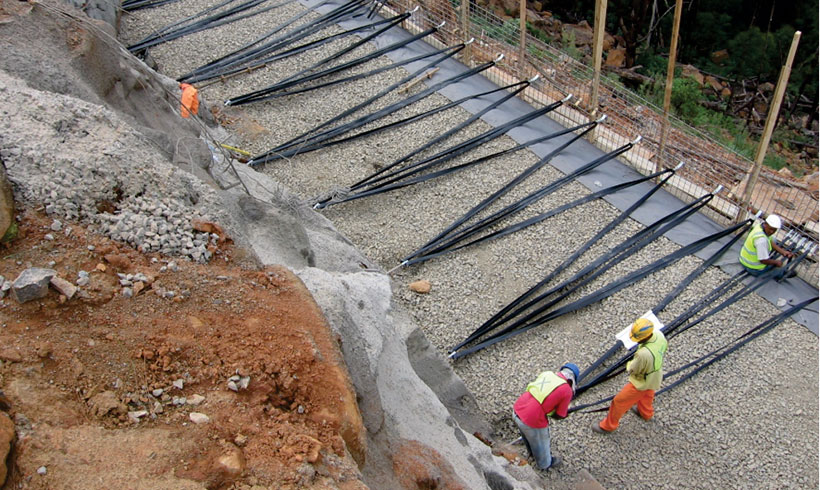The 25-Second Trick For Geotechnical Engineering For Construction Projects
Table of ContentsExamine This Report about Geotechnical Engineering For Construction ProjectsThe 7-Minute Rule for Geotechnical Engineering For Construction ProjectsGeotechnical Engineering For Construction Projects Fundamentals ExplainedOur Geotechnical Engineering For Construction Projects DiariesThe smart Trick of Geotechnical Engineering For Construction Projects That Nobody is Talking AboutIndicators on Geotechnical Engineering For Construction Projects You Need To Know
The function of geotechnical engineering considerably manages realizing the functions of dirt and rock, which might differ significantly by their thickness, moisture content etc. These features must be analyzed by geotechnical engineers to anticipate their activities under various situations. The safety along with security of frameworks are impacted by dirt problems, making this analysis needed.A geotechnical designer will analyze dirt to figure out the bearing capacity of the planet and advise appropriate foundation types, such as superficial foundations, deep foundations like heaps, or specialized solutions like drifting structures for soft soils. Recognizing the functions and activities of soil and rock, along with how they connect with buildings that have actually been set up on or within them, is one of the main explanations for why geotechnical engineering is vital.
In enhancement to structural preparation and building, geotechnical engineering is additionally important to the repair and upkeep of pre-existing frameworks. Age-related deterioration or additional issues could influence a framework's security and efficiency. Environmental defense is completed through geotechnical engineering. Know-how in air, water, and dirt quality upkeep is used by geotechnical engineers to reduce the adverse results of projects.
To sum up, geotechnical engineering is a vital self-control that preserves the resilience and stability of civil infrastructure. Geotechnical designers add to making structure projects effective all over the world by recognizing the practices of planet materials and applying proper planning strategies.
Geotechnical Engineering For Construction Projects Can Be Fun For Everyone
The foundational security of any kind of job is necessary. Geotechnical engineering plays an essential role in ensuring that structures are constructed on strong ground, literally and figuratively. By checking out soil, rock, and subsurface problems, geotechnical designers offer essential insights that assist in the layout, building, and maintenance of buildings and facilities.

See This Report about Geotechnical Engineering For Construction Projects
Lab testing: Figuring out the residential properties of dirt and rock. A number of prominent building and construction jobs have efficiently used geotechnical design to ensure their security and safety and security.

As a leader in geotechnical engineering, BECC Inc. is committed to providing cutting-edge and effective services that meet the highest standards of high quality and security. To find out more on how BECC Inc. can support your following building and construction task, contact us today and let Bonuses us aid you develop on solid ground.
William Rankine, an engineer and physicist, developed an alternative to Coulomb's earth pressure concept. Albert Atterberg developed the clay uniformity indices that are still utilized today for soil category. In 1885, Osborne Reynolds acknowledged that shearing causes volumetric dilation of thick materials and contraction of loose granular products. Modern geotechnical engineering is said to have begun in 1925 with the magazine of Erdbaumechanik by Karl von Terzaghi, a mechanical engineer and geologist.
Fascination About Geotechnical Engineering For Construction Projects
Terzaghi likewise created the framework for theories of birthing ability of structures, and the concept for prediction of the rate of negotiation of clay layers as a result of combination. Afterwards, Maurice Biot totally created the three-dimensional soil debt consolidation concept, expanding the one-dimensional model previously created by Terzaghi to much more basic hypotheses and introducing the collection of fundamental equations of Poroelasticity.
Geotechnical engineers check out and determine the residential or commercial properties of subsurface conditions and materials. They also design matching earthworks and keeping structures, tunnels, and structure foundations, and might manage and review websites, which may better entail site tracking in addition to the risk assessment and mitigation of all-natural risks - Geotechnical Engineering for Construction Projects. Geotechnical engineers and engineering rock hounds do geotechnical examinations to obtain information on the physical properties of dirt and rock hidden and beside a site to design earthworks and structures for suggested structures and for the fixing of distress to earthworks and structures triggered by subsurface problems.
The 2-Minute Rule for Geotechnical Engineering For Construction Projects
Still, they are sometimes utilized to enable a geologist or engineer to be lowered right into the borehole for straight visual and hands-on exam of the soil and rock stratigraphy. Different soil samplers exist to meet the needs of various design projects. The typical infiltration examination, which utilizes a thick-walled split spoon sampler, is the most usual way to collect disrupted samples.

If the interface in between the mass and the base of a slope has a complicated geometry, slope stability analysis is tough and mathematical remedy techniques are called for. Usually, the interface's precise geometry is unknown, and a simplified interface view it now geometry is assumed. Finite inclines require three-dimensional designs to be assessed, so most slopes are assessed assuming that they are infinitely large and can be represented by two-dimensional versions.
Some Known Questions About Geotechnical Engineering For Construction Projects.
Producing the style based on a working hypothesis of behavior expected under the most likely conditions. Selection of quantities to be observed as construction profits and computing their prepared for worths based on the working theory under the most undesirable conditions.
Dimension of amounts and analysis of real conditions. Design modification per actual conditions The observational method appropriates for building that has currently started when an unanticipated growth takes place or when a failing or accident looms or has actually already happened. It disagrees for projects whose style can not be modified during building.